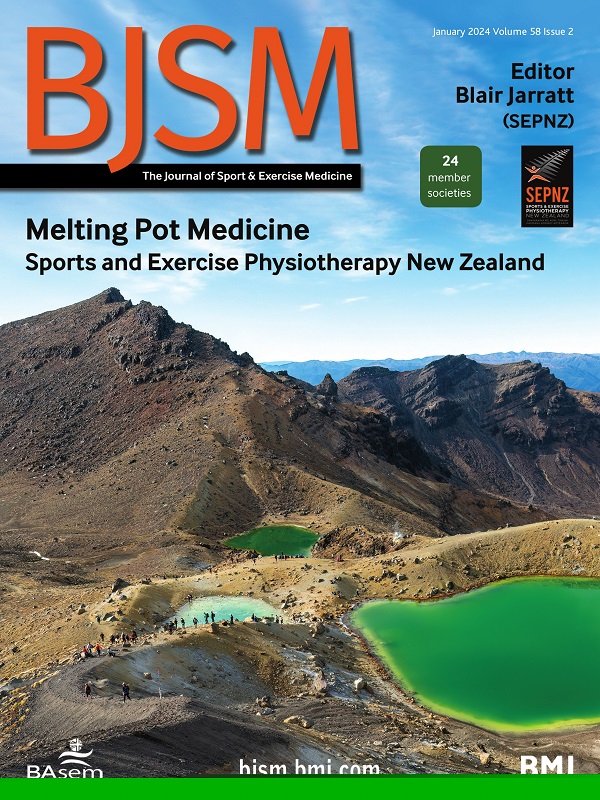Combining evidence and practice to optimise neck training aimed at reducing head acceleration events in sport: a systematic review and Delphi-consensus study
IF 11.6
1区 医学
Q1 SPORT SCIENCES
引用次数: 0
Abstract
Head acceleration events (HAEs) can potentially have adverse consequences for athlete brain health. In sports, in which head injuries have the highest incidence, identifying strategies to reduce HAE frequency and magnitude is a priority. Neck training is a potential strategy to mitigate against the magnitude of HAEs. This two-part study aimed to (1) systematically review the literature of neck training interventions in sport and (2) undertake an expert Delphi consensus on the best practices for neck training implementation to reduce HAEs in sport. Part I: a systematic search of four databases was undertaken from the earliest records to September 2024. The PRISMA (Preferred Reporting Items for Systematic Review and Meta-Analysis) guidelines were followed, and a quality assessment was completed using a modified Downs and Black assessment tool and the GRADE (Grading of Recommendations Assessment, Development and Evaluation). Papers were eligible if they both (1) implemented a reproducible exercise intervention targeting the neck within collision, combat or motor sport, and (2) assessed outcomes relating to either: the physical profile of the neck; head/neck injury incidence; and/or HAEs. Part II: 18 international experts, with experience in research and/or applied practice of neck exercise training, concussion and/or HAEs, reviewed the part I findings before completing a three-round Delphi consensus process. Part I included 21 papers, highlighting the heterogeneity of existing interventions. Part II resulted in 57 statements coded into five categories: contextual factors (n=17), neck training periodisation (n=12), training adaptations (n=10), neck training content (n=15) and athlete adherence (n=3). This study presents recommendations for neck exercise training aiming to reduce HAEs in sport, supporting both practice and future research.结合证据和实践,优化颈部训练,旨在减少运动中的头部加速事件:系统回顾和德尔福共识研究
头部加速事件(HAEs)可能对运动员的大脑健康产生潜在的不良后果。在头部损伤发生率最高的运动中,确定降低HAE发生频率和程度的策略是当务之急。颈部训练是缓解HAEs严重程度的潜在策略。这项分为两部分的研究旨在(1)系统地回顾运动中颈部训练干预的文献,(2)就颈部训练实施以减少运动中HAEs的最佳实践进行专家德尔菲共识。第一部分:从最早的记录到2024年9月,对四个数据库进行了系统检索。遵循PRISMA(系统评价和荟萃分析首选报告项目)指南,使用改进的Downs和Black评估工具和GRADE(建议评估、发展和评估分级)完成质量评估。如果论文(1)在碰撞、战斗或汽车运动中实施了针对颈部的可重复运动干预,并且(2)评估了与以下两项相关的结果:颈部的身体特征;头颈部损伤发生率;和/或ha。第二部分:18位具有颈部运动训练、脑震荡和/或HAEs研究和/或应用实践经验的国际专家,在完成三轮德尔菲共识过程之前回顾了第一部分的研究结果。第一部分包括21篇论文,强调了现有干预措施的异质性。第二部分产生了57个陈述,分为五类:情境因素(n=17),颈部训练周期(n=12),训练适应性(n=10),颈部训练内容(n=15)和运动员依从性(n=3)。本研究提出了颈部运动训练的建议,旨在减少运动中的HAEs,支持实践和未来的研究。
本文章由计算机程序翻译,如有差异,请以英文原文为准。
求助全文
约1分钟内获得全文
求助全文
来源期刊
CiteScore
27.10
自引率
4.90%
发文量
217
审稿时长
3-8 weeks
期刊介绍:
The British Journal of Sports Medicine (BJSM) is a dynamic platform that presents groundbreaking research, thought-provoking reviews, and meaningful discussions on sport and exercise medicine. Our focus encompasses various clinically-relevant aspects such as physiotherapy, physical therapy, and rehabilitation. With an aim to foster innovation, education, and knowledge translation, we strive to bridge the gap between research and practical implementation in the field. Our multi-media approach, including web, print, video, and audio resources, along with our active presence on social media, connects a global community of healthcare professionals dedicated to treating active individuals.

 求助内容:
求助内容: 应助结果提醒方式:
应助结果提醒方式:


